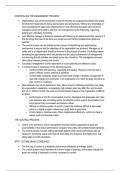CONTROLLING THE MANAGEMENT PROCESS
• Organisations use control procedures to ensure that they are progressing towards their goals,
and that their resources are being used properly and productively. Without any knowledge of
how successfully the plans were implemented or how effectively the goals were achieved,
managers would not be able to start the next management cycle of planning, organising,
leading and, ultimately, controlling.
• 2/An effective manager is therefore someone who follows up on planned activities, seeing to it
that the things that need to be done are carried out and that the predetermined goals are
reached.
• The control process can be defined as the process of establishing and implementing
mechanisms to ensure that the objectives of the organisation are achieved. Managers at all
levels and in all departments should be involved in the process of control. Controlling means
narrowing the gap between what was planned and the actual achievement of management,
and ensuring that all activities are carried out as they should be. The management process
takes place between planning and control.
• Successful management is often dependent on sound planning and effective control.
• A control process is necessary for the following reasons:
o Control is linked with planning, organising and leading. Planning is the first step in
control. Without control, planning is pointless.
o Control helps companies adapt to environmental change. It enables management to
cope with change and uncertainty. If an organisation is to reach its goals according to
plan, control is necessary.
• Raw materials may not be delivered on time, labour unrest or defective machinery may delay
the organisation's operations, unexpectedly high interest rates may affect the cost structure,
and so on. Without control, the impact of environmental change on the organisation is difficult
to detect.
o Control helps to limit the accumulation of errors. Managers and employees can make
poor decisions and committing errors. An effective control system should detect such
errors before they accumulate and become critical.
o Without an effective system of control, it would be extremely difficult to spot weak
points in a highly complex network and rectify them in good time.
o Control helps to minimise costs. When implemented effectively, control can help to
reduce costs and increase output.
THE CONTROL PROCESS
• control is the process by which management ensures that the organisation's goals are
accomplished or that actual performance compares favourably with predetermined standards.
• The control process includes setting standards against which actual performance can be
measured, measuring actual performance, evaluating any deviations that might occur and
taking steps to rectify deviations.
STEP 1 ESTABLISHING STANDARDS
• The first step in control is to establish performance standards at strategic points.
• The control system should therefore be a mirror image of planning, as the plans indicate the
goals and setting of standards or norms necessary for control.
, • A performance or control standard is a planned target against which the actual performance will
be compared.
• To make the control process possible and worthwhile, the performance standard should be
relevant, realistic, attainable and measurable, so that there can be no doubt as to whether the
actual performance meets the standard.
o Profit standards indicate how much profit the business expects to make over a given
period.
o Market-share standards indicate what share of the total market the business is aiming
to conquer.
o Productivity standards are indicated by expressing inputs and outputs in relation to
each other as ratios. Such ratios indicate the relative productivity with which tasks are
performed.
o Staff-development standards indicate the effectiveness of training programmes for
staff.
o Standards are a function of the goals that are set in the planning phase.
• Performance standards, enable management to distinguish between acceptable and
unacceptable performance. They also enable management to monitor strategies and goals. To
be effective, these standards should be the responsibility of a particular individual at some
strategic point.
STEP 2: MEASURE ACTUAL PERFORMANCE
• The collection of information and reporting on actual performance are continuous activities.
Another important requirement regarding the measurement of actual achievement is that the
reports should be absolutely reliable. Unless they are totally accurate, control will not be
effective. Moreover, observation and measurement must be carried out at the necessary
strategic points and according to the standards determined by the control system.
• Important considerations in the measurement and reporting of activities are which information
and how much information should be fed back, and to whom. Only important or exceptional
disparities between real and planned achievement are reported to top management. Less
important deviations are dealt with by employees.
• Management information is presented to indicate the disparities between performance
standards and actual performance, and to enable management to concentrate on deviations or
problem areas.
STEP 3 EVALUATE DEVIATIONS
• The determination of the performance gap between the performance standard and actual
performance. It is important to know why a standard has only been matched and not exceeded,
or even why performance has been much better than the standard.
• It must be determined whether both the performance standard and the actual performance
have been set and measured objectively. If the standard is set too high, further examination of
apparent deviations may be a waste of time.
• It must be determined whether the deviations are large enough to justify further investigation.
Upper and lower limits should be set for each deviation, and only those deviations that exceed
the limits should be subjected to further examination.
• All the reasons and activities responsible for the deviation should be identified.





